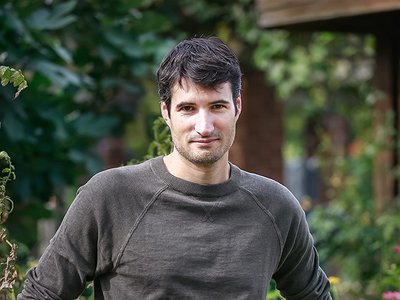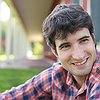Part 2
Could you take us through a day in your life, from a possible morning routine through to your work? Do you have a fixed schedule? How do music and other aspects of your life feed back into each other - do you separate them or instead try to make them blend seamlessly?
In these mid-pandemic days, it is hard for me to remember life as usual! I have two young children (a 3-year-old and 6-month-old), and with them still out of daycare, much of my day revolves around taking care of them. I also have a full-time teaching job at West Chester University, so during the school year, I spend a lot of time doing teaching-related work.
On days when I am fully free to produce music, I can usually get going by 9 a.m. or so. I rely on exercise, usually in the late afternoon to provide a significant physical and mental break. My professional life bleeds into my social life most overtly when attending or taking part in concerts something that I am truly missing these days.
Could you describe your creative process on the basis of a piece or album that's particularly dear to you, please? Where did the ideas come from, how were they transformed in your mind, what did you start with and how do you refine these beginnings into the finished work of art?
I will explain the process for the title track of my album Terrain, since it’s the most recent piece I’ve written. I composed the work to act as a reaction to, or perhaps synthesis of, the two other works already present on the album. First, I came up with a sketch of the music by altering droney samples from those first two pieces. Then I recruited poet Zach Savich to draft some text that was inspired (musically, thematically, and textually) by the first two works.
Next, I composed a series of cello arpeggios above the drones and asked the cellist Ashley Bathgate to record them for me and give me feedback. I also had her create some noisy cello effects, which I dropped in over the drones. I would ask her for example, to play a harmonic gliss with extreme bow pressure; and then had her improvise some noises herself.
Once I had some text from Zach, I wrote a series of simple melodies. I then workshopped those melodies with both singers, Theo Blackmann and Jodie Landau. While listening to an instrumental sketch I had made, they each recorded my own melodies and improvised their own. Next, I chose the melodies I liked mostly ones I had written myself, but also a few stellar ones they had improvised.
After that, the process was just a series of refinements: asking Zach to expand certain parts of the text, getting all three performers to re-record lines once I had a better sense of the form and development. I had mixed the work at each stage, but the most significant mixing came as I was finishing up the composition. As is usually the case for me now, after refining the mix as well as I could myself, I hired a dedicated mixing engineer (Nick Tipp, in this case) to take it to the next level.
There are many descriptions of the ideal state of mind for being creative. What is it like for you? What supports this ideal state of mind and what are distractions? Are there strategies to enter into this state more easily?
I am not too unique in this regard. Just having an extended chunk of free time is essential. Other than that, I rely on caffeine in order to keep self-doubt at bay, and exercise for physical and mental breaks. Like most people, I have a love-hate relationship with the internet: I am often more productive if I can avoid it for a while, but I also often find it necessary for inspiration and information.
How is playing live and writing music in the studio connected? What do you achieve and draw from each experience personally? How do you see the relationship between improvisation and composition in this regard?
In my “classical” composition upbringing, the standard approach is to first compose the music in isolation; then an ensemble performs it; and then it gets recorded in the studio. These three steps have become intertwined. I need to workshop material with performers and need to process their sounds in the studio in order to figure out the direction of my composition.
Once the pandemic is over, I will be touring with the three performers mentioned above, Theo Bleckmann and Jodie Landau on vocals, Ashley Bathgate on cello, me on laptop. Our live performances will be inspired by my album release, but my intent is that we will function as a sort of band: we’re building in time to first collaborate on arrangements of other pieces, and we’ll see where rehearsals take us. I expect there to be a mixture of pre-determined music written by me, guided improvisation, and music that we develop together. I have never really worked this way before, and I’m excited to see what transpires.
How do you see the relationship between the 'sound' aspects of music and the 'composition' aspects? How do you work with sound and timbre to meet certain production ideas and in which way can certain sounds already take on compositional qualities?
I love this question! I mean, I am not sure I know how to answer it, but it is something I’ve thought about a lot lately. I think the issue is that people tend to distinguish “timbre” from “composition” in an artificial way. We have been taught to think that parameters like pitch and rhythm are the basis of composition, while over the last several years, even over the past several decades music has progressed through timbral development, not melodic or harmonic development. Radio hits today sound different than those in the 80s or 90s because of the instruments used and the way those instruments are treated. In the contemporary classical world, composers are pushing the envelope by immersing us in new sonorities, not through new notes on the page.
The composition and sonic palette are inextricably related. As I noted above, I usually start a composition by finding a sound I like enough to have it last a long time; then I find out how to vary its timbre to keep it interesting, and also figure out what to put on top of it, what goes with it timbrally.
Our sense of hearing shares intriguing connections to other senses. From your experience, what are some of the most inspiring overlaps between different senses - and what do they tell us about the way our senses work? What happens to sound at its outermost borders?
I do not think I have much to offer here! I’m not a synaesthete, and don’t feel qualified to answer anything about the music-brain relationship.
Art can be a purpose in its own right, but it can also directly feed back into everyday life, take on a social and political role and lead to more engagement. Can you describe your approach to art and being an artist?
Although I am a politically and socially engaged person, my work is generally more spiritual or meditative than overtly political. Perhaps because of this, I often find myself borrowing from religious practice. My Stabat Mater Dolorosa, for example, is inspired by an extremely slowed-down version of the Pergolesi piece, but is intended to contemplate grief more broadly than just Mary’s grief over Christ’s death. My recent vocal-theater piece Threnos (for the Throat) is structured as a pseudo-liturgical service about the slaughter of animals.
It is remarkable, in a way, that we have arrived in the 21st century with the basic concept of music still intact. Do you have a vision of music, an idea of what music could be beyond its current form?
As I have mentioned a few times, I mostly come from an “academic” or “classical” music background, and my take in those worlds, at least, is that there will continue to be a greater inclusion of different styles. In the wake of the George Floyd protests, a lot of large institutions (both academic and professional) are grappling more than ever with the inherent white supremacy of their repertoire. I don’t think the solution is really an orchestra accompanying Sir Mix-A-Lot as the Seattle Symphony did a few years ago, but instead a hybridization of styles that develops more organically over time, as artistic directors open their minds up to different kinds of collaboration and community involvement. Then again, these institutions might be too large to evolve smoothly, and will be left in the dust as more grassroots organizations lead the charge.






